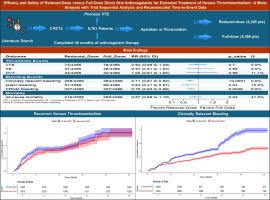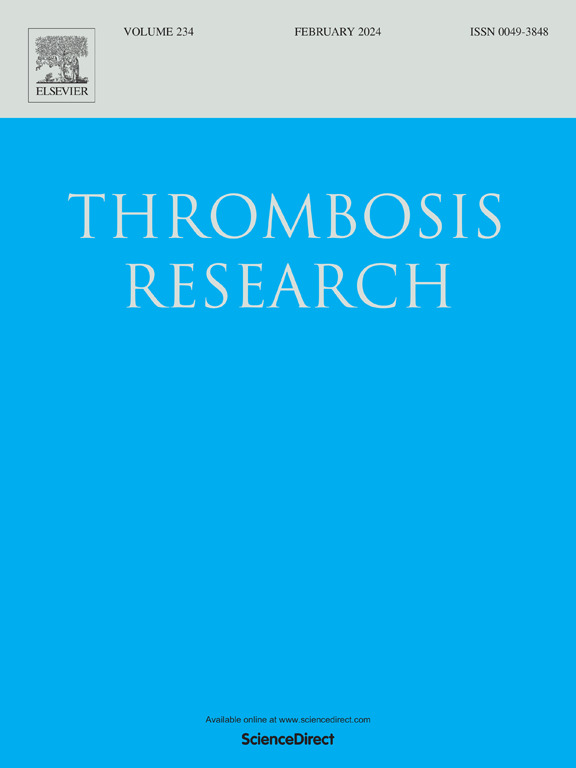Efficacy and safety of reduced-dose versus full-dose direct oral anticoagulants for extended treatment of venous thromboembolism: A meta-analysis with trial sequential analysis and reconstructed time-to-event data
IF 3.4
3区 医学
Q1 HEMATOLOGY
引用次数: 0
Abstract
Background
While current guidelines recommend extended therapeutic anticoagulation for venous thromboembolism (VTE), the optimal dosing strategy for direct oral anticoagulants (DOACs) remains uncertain, particularly in cancer-associated VTE. This meta-analysis evaluates the efficacy and safety of reduced-dose versus full-dose DOACs for extended VTE treatment.
Methods
We conducted a comprehensive search of major electronic databases through April 2025 for randomized controlled trials (RCTs) comparing reduced-dose versus full-dose DOACs for VTE treatment. Pooled risk ratios (RR) with 95 % confidence intervals (CI) were calculated using random-effects models. Time-to-event data were reconstructed from Kaplan-Meier curves. Trial sequential analysis (TSA) was employed to assess the conclusiveness of the evidence.
Results
Our analysis included five RCTs involving 8781 patients. Reduced-dose DOACs were associated with comparable efficacy to full-dose therapy in preventing recurrent VTE (RR, 0.94; 95 % CI, 0.68–1.29; P = 0.70), supported by time-to-event analysis (HR, 0.89; 95 % CI 0.78–1.02; p = 0.10). However, reduced-dose regimens significantly reduced major or clinically relevant non-major bleeding (RR, 0.71; 95 % CI 0.61–0.82; P < 0.0001), with consistent findings on Kaplan-Meier analysis (HR, 0.61; 95 % CI 0.57–0.66; P < 0.001). Subgroup analyses showed consistent results in patients with and without active cancer, and also across different DOAC types (apixaban and rivaroxaban). No differences were observed in all-cause mortality. TSA confirmed sufficient evidence for both efficacy and safety outcomes.
Conclusion
Reduced-dose DOACs were as effective as full-dose regimens in preventing recurrent VTE, with a better safety profile, suggesting they may be preferred for patients requiring extended anticoagulation, especially those at high risk of recurrence.
Prospero ID
CRD420251048675.

减少剂量与全剂量直接口服抗凝剂延长治疗静脉血栓栓塞的疗效和安全性:一项荟萃分析,包括试验序列分析和重建的事件发生时间数据。
背景:虽然目前的指南推荐延长静脉血栓栓塞(VTE)的抗凝治疗,但直接口服抗凝剂(DOACs)的最佳剂量策略仍然不确定,特别是在癌症相关的VTE中。本荟萃分析评估了减少剂量与全剂量DOACs在延长静脉血栓栓塞治疗中的疗效和安全性。方法:我们对截至2025年4月的主要电子数据库进行了全面检索,以比较减少剂量与全剂量DOACs治疗静脉血栓栓塞的随机对照试验(rct)。采用随机效应模型计算95%置信区间(CI)的合并风险比(RR)。时间-事件数据由Kaplan-Meier曲线重建。采用试验序列分析(TSA)来评估证据的结论性。结果:我们的分析纳入了5项随机对照试验,涉及8781例患者。减少剂量doac与全剂量治疗在预防静脉血栓栓塞复发方面的疗效相当(RR, 0.94; 95% CI, 0.68-1.29; P = 0.70),时间-事件分析也支持这一观点(HR, 0.89; 95% CI, 0.78-1.02; P = 0.10)。结论:在预防静脉血栓栓塞复发方面,低剂量doac与全剂量方案同样有效,且安全性更好,提示对于需要延长抗凝时间的患者,尤其是复发风险高的患者,它们可能是首选。普洛斯彼罗id: CRD420251048675。
本文章由计算机程序翻译,如有差异,请以英文原文为准。
求助全文
约1分钟内获得全文
求助全文
来源期刊

Thrombosis research
医学-外周血管病
CiteScore
14.60
自引率
4.00%
发文量
364
审稿时长
31 days
期刊介绍:
Thrombosis Research is an international journal dedicated to the swift dissemination of new information on thrombosis, hemostasis, and vascular biology, aimed at advancing both science and clinical care. The journal publishes peer-reviewed original research, reviews, editorials, opinions, and critiques, covering both basic and clinical studies. Priority is given to research that promises novel approaches in the diagnosis, therapy, prognosis, and prevention of thrombotic and hemorrhagic diseases.
 求助内容:
求助内容: 应助结果提醒方式:
应助结果提醒方式:


